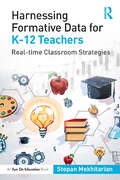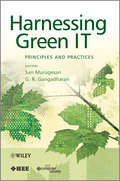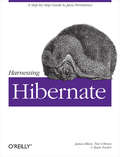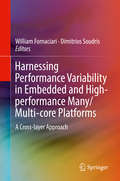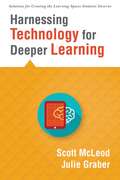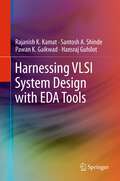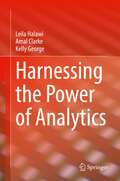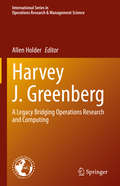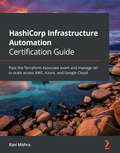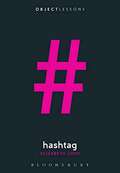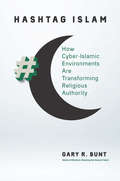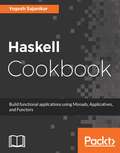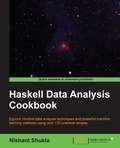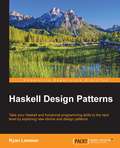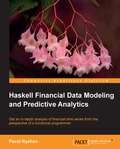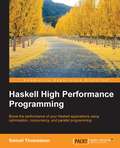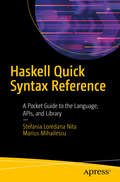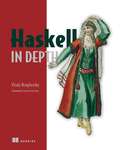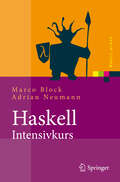- Table View
- List View
Harnessing Formative Data for K-12 Teachers: Real-time Classroom Strategies
by Stepan MekhitarianHarnessing Formative Data for K-12 Teachers prepares teachers to apply real-time formative data to classroom instruction amid the expansion of online and blended learning in schools. In today’s changing, technology-enhanced educational landscape, teachers must rethink how to generate and use formative data to inform planning and develop systems that lead to all students’ success. This book’s strategic insights into actionable formative data use will yield differentiated supports for students, helping teachers to foster greater academic outcomes, independent self-monitoring, and readiness for college, career, and lifelong learning. Each chapter includes connections to social justice, best practices for applying data points and field-tested tips for technology integration, and a host of interactive planning guides to support implementation.
Harnessing Green IT
by San Murugesan G. R. Gangadharan"Ultimately, this is a remarkable book, a practical testimonial, and a comprehensive bibliography rolled into one. It is a single, bright sword cut across the various murky green IT topics. And if my mistakes and lessons learned through the green IT journey are any indication, this book will be used every day by folks interested in greening IT." -- Simon Y. Liu, Ph.D. & Ed.D., Editor-in-Chief, IT Professional Magazine, IEEE Computer Society, Director, U.S. National Agricultural Library This book presents a holistic perspective on Green IT by discussing its various facets and showing how to strategically embrace it Harnessing Green IT: Principles and Practices examines various ways of making computing and information systems greener - environmentally sustainable -, as well as several means of using Information Technology (IT) as a tool and an enabler to improve the environmental sustainability. The book focuses on both greening of IT and greening by IT - complimentary approaches to attaining environmental sustainability. In a single volume, it comprehensively covers several key aspects of Green IT - green technologies, design, standards, maturity models, strategies and adoption -, and presents a clear approach to greening IT encompassing green use, green disposal, green design, and green manufacturing. It also illustrates how to strategically apply green IT in practice in several areas. Key Features: Presents a comprehensive coverage of key topics of importance and practical relevance - green technologies, design, standards, maturity models, strategies and adoption Highlights several useful approaches to embracing green IT in several areas Features chapters written by accomplished experts from industry and academia who have first-hand knowledge and expertise in specific areas of green IT Presents a set of review and discussion questions for each chapter that will help the readers to examine and explore the green IT domain further Includes a companion website providing resources for further information and presentation slides This book will be an invaluable resource for IT Professionals, academics, students, researchers, project leaders/managers, IT business executives, CIOs, CTOs and anyone interested in Green IT and harnessing it to enhance our environment.
Harnessing Hibernate
by Timothy M. O'Brien Ryan Fowler James ElliotHarnessing Hibernate is an ideal introduction to the popular framework that lets Java developers work with information from a relational database easily and efficiently. Databases are a very different world than Java objects, and they often involve people with different skills and specializations. With Hibernate, bridging these two worlds is significantly easier, and with this book, you can get up to speed with Hibernate quickly. Rather than present you with another reference, Harnessing Hibernate lets you explore the system, from download and configuration through a series of projects that demonstrate how to accomplish a variety of practical goals. The new edition of this concise guide walks you through Hibernate's primary features, which include mapping from Java classes to database tables, and from Java data types to SQL data types. You will also learn about Hibernate's data query and retrieval facilities, and much more. By reading and following along with the examples, you can get your own Hibernate environment set up quickly and start using it for real-world tasks right away. Harnessing Hibernate teaches you how to: * Perform Object/Relational mapping * Work with persistent data from Java code * Work with groups and relationships between objects * Extend Hibernate's rich type support for your own needs * Simplify query creation using criteria and examples * Use the Hibernate Query Language (HQL) and understand how it differs from SQL * Use Hibernate in conjunction with Spring * Use Hibernate in conjunction with other packages, such as the Stripes web framework and the Eclipse IDE Once you're past the first few chapters, you can jump to topics that you find particularly interesting or relevant. All background material and explanations of how Hibernate works and why is in the service of a focused task. Source code can be downloaded from the book's website. If using SQL is an uncomfortable chore, Harnessing Hibernate offers you an effective and trouble-free method for working with the information you store in your applications.
Harnessing Hibernate: Step-by-step Guide to Java Persistence
by James Elliott Timothy M. O'Brien Ryan FowlerHarnessing Hibernate is an ideal introduction to the popular framework that lets Java developers work with information from a relational database easily and efficiently. Databases are a very different world than Java objects, and they often involve people with different skills and specializations. With Hibernate, bridging these two worlds is significantly easier, and with this book, you can get up to speed with Hibernate quickly.Rather than present you with another reference, Harnessing Hibernate lets you explore the system, from download and configuration through a series of projects that demonstrate how to accomplish a variety of practical goals. The new edition of this concise guide walks you through Hibernate's primary features, which include mapping from Java classes to database tables, and from Java data types to SQL data types. You will also learn about Hibernate's data query and retrieval facilities, and much more.By reading and following along with the examples, you can get your own Hibernate environment set up quickly and start using it for real-world tasks right away. Harnessing Hibernate teaches you how to:Perform Object/Relational mappingWork with persistent data from Java codeWork with groups and relationships between objectsExtend Hibernate's rich type support for your own needsSimplify query creation using criteria and examplesUse the Hibernate Query Language (HQL) and understand how it differs from SQLUse Hibernate in conjunction with SpringUse Hibernate in conjunction with other packages, such as the Stripes web framework and the Eclipse IDEOnce you're past the first few chapters, you can jump to topics that you find particularly interesting or relevant. All background material and explanations of how Hibernate works and why is in the service of a focused task. Source code can be downloaded from the book's website.If using SQL is an uncomfortable chore, Harnessing Hibernate offers you an effective and trouble-free method for working with the information you store in your applications.
Harnessing Omni-Channel Marketing Strategies for Fashion and Luxury Brands
by Wilson OzuemThis book provides a contemporary theoretical insight into the fashion and luxury industry, addressing potential gray areas within the literature. The authors analyze the luxury and fashion industry using multiple perspectives, allowing for a critical com
Harnessing Performance Variability in Embedded and High-performance Many/Multi-core Platforms: A Cross-layer Approach
by Dimitrios Soudris William FornaciariThis book describes the state-of-the art of industrial and academic research in the architectural design of heterogeneous, multi/many-core processors. The authors describe methods and tools to enable next-generation embedded and high-performance heterogeneous processors to confront cost-effectively the inevitable variations by providing Dependable-Performance: correct functionality and timing guarantees throughout the expected lifetime of a platform under thermal, power, and energy constraints. Various aspects of the reliability problem are discussed, at both the circuit and architecture level, the intelligent selection of knobs and monitors in multicore platforms, and systematic design methodologies. The authors demonstrate how new techniques have been applied in real case studies from different applications domain and report on results and conclusions of those experiments. Enables readers to develop performance-dependable heterogeneous multi/many-core architectures Describes system software designs that support high performance dependability requirements Discusses and analyzes low level methodologies to tradeoff conflicting metrics, i.e. power, performance, reliability and thermal management Includes new application design guidelines to improve performance dependability
Harnessing Technology for Deeper Learning
by Scott McLeod; Julie GraberSeeking a New Approach; Introducing the 4 Shifts Protocol; Redesigning Elementary School Lessons and Units; Redesigning Secondary Lessons and Units; Designing From Standards; Implementing the Protocol Tips, Strategies, and Other Suggestions.
Harnessing VLSI System Design with EDA Tools
by Hansraj Guhilot Santosh A. Shinde Pawan K. Gaikwad Rajanish K. KamatWith the proliferation of VHDL, the reference material also grew in the same order. Today there is good amount of scholarly literature including many books describing various aspects of VHDL. However, an indepth review of these books reveals a different story. Many of them have emerged simply as an improved version of the manual. While some of them deal with the system design issues, they lack appropriate exemplifying to illustrate the concepts. Others give large number of examples, but lack the VLSI system design issues. In nutshell, the fact which gone unnoticed by most of the books, is the growth of the VLSI is not merely due to the language itself, but more due to the development of large number of third party tools useful from the FPGA or semicustom ASIC realization point of view. In the proposed book, the authors have synergized the VHDL programming with appropriate EDA tools so as to present a full proof system design to the readers. In this book along with the VHDL coding issues, the simulation and synthesis with the various toolsets enables the potential reader to visualize the final design. The VHDL design codes have been synthesized using different third party tools such as Xilinx Web pack Ver.11, Modelsim PE, Leonrado Spectrum and Synplify Pro. Mixed flow illustrated by using the above mentioned tools presents an insight to optimize the design with reference to the spatial, temporal and power metrics.
Harnessing the Power of Analytics
by Leila Halawi Amal Clarke Kelly GeorgeThis text highlights the difference between analytics and data science, using predictive analytic techniques to analyze different historical data, including aviation data and concrete data, interpreting the predictive models, and highlighting the steps to deploy the models and the steps ahead. The book combines the conceptual perspective and a hands-on approach to predictive analytics using SAS VIYA, an analytic and data management platform. The authors use SAS VIYA to focus on analytics to solve problems, highlight how analytics is applied in the airline and business environment, and compare several different modeling techniques. They decipher complex algorithms to demonstrate how they can be applied and explained within improving decisions.
Harvard Envy
by Andrew S RosenHarvard Envy is a chapter excerpt from Change.edu coming out October 18, 2011.Exploring the limitations of the exclusive, tradition-bound world of higher education, innovator Andrew S. Rosen, chairman and CEO of Kaplan, Inc., delivers a vision for making a world-class college experience available to students of all backgrounds. Little is known about John Harvard, who bequeathed his books and £779 to a fledgling college on the Charles River in the 1630s, but the institution that bears his name has become the gold standard for universities worldwide. Tracing this fascinating history, and the history of American higher education overall, "Harvard Envy" raises important questions about the effect of super-elite campuses on America's educational landscape. Just as Congress hotly debated whether to approve land-grant colleges in the nineteenth century, opening the doors of higher education to farmers, we face a competitive new demand for a highly educated workforce. Yet many colleges continue to insist on limiting access, and many college applicants continue to believe that exclusive institutions deliver the highest quality. With an eye-opening examination of the U.S. News and World Report college rankings and other barometers, "Harvard Envy" takes an enlightened look at how universities allocate resources and talent. Offering an inspiring alternative to the Ivory Tower playbook, Andrew S. Rosen presents a bold, cost-effective new vision for a truly competitive higher education system that serves both individual and national interests.
Harvey J. Greenberg: A Legacy Bridging Operations Research and Computing (International Series in Operations Research & Management Science #295)
by Allen HolderThis volume chronicles the high impact research career of Harvey Greenberg (1940-2018), and in particular, it reviews historical contributions, presents current research projects, and suggests future pursuits. This volume addresses several of his most distinguished hallmarks, including model analysis, model generation, infeasibility diagnosis, sensitivity analysis, parametric programming, energy modeling, and computational biology. There is also an overview chapter on the emergence of computational OR, and in particular, how literature venues have changed the course of OR research. He developed Computer-Assisted Analysis in the 1970s and 80s, creating an artificially intelligent environment for analyzing mathematical programming models and their results. This earned him the first INFORMS Computing Society (ICS) Prize for "research excellence in the interfaces between operations research and computer science" in 1986, notably for his software system, ANALYZE. In 1993, he wrote the first book in the Springer OR/CS Series entitled A Computer-Assisted Analysis System for Mathematical Programming Models and Solutions: A User’s Guide for ANALYZE. He applied OR methods to CS problems, ranging from using queuing theory for optimal list structure design to using integer programming for bioinformatic database search. He also applied CS to OR problems, ranging from super-sparse information structures to the use of compiler design in ANALYZE. This book can serve as a guide to new researchers, and will report the historical trajectory of OR as it solves current problems and forecasts future applications through the accomplishments of Harvey Greenberg.
Hash Crack: Password Cracking Manual (V3 Series)
by Joshua PicoletThe Hash Crack: Password Cracking Manual v3 is an expanded reference guide for password recovery (cracking) methods, tools, and analysis techniques. A compilation of basic and advanced techniques to assist penetration testers and network security professionals evaluate their organization's posture. The Hash Crack manual contains syntax and examples for the most popular cracking and analysis tools and will save you hours of research looking up tool usage. It also includes basic cracking knowledge and methodologies every security professional should know when dealing with password attack capabilities. Hash Crack contains all the tables, commands, online resources, and more to complete your cracking security kit. This version expands on techniques to extract hashes from a myriad of operating systems, devices, data, files, and images. Lastly, it contains updated tool usage and syntax for the most popular cracking tools.
HashiCorp Infrastructure Automation Certification Guide: Pass the Terraform Associate exam and manage IaC to scale across AWS, Azure, and Google Cloud
by Ravi MishraLeverage Terraform's capabilities to reuse code, write modules, automate deployments, and manage infrastructure stateKey FeaturesPerform complex enterprise-grade infrastructure deployments using Terraform v1.0, the latest version of TerraformLearn to scale your infrastructure without introducing added deployment complexitiesUnderstand how to overcome infrastructure deployment challengesBook DescriptionTerraform is a highly sought-after technology for orchestrating infrastructure provisioning. This book is a complete reference guide to enhancing your infrastructure automation skills, offering up-to-date coverage of the HashiCorp infrastructure automation certification exam. This book is written in a clear and practical way with self-assessment questions and mock exams that will help you from a HashiCorp infrastructure automation certification exam perspective. This book covers end-to-end activities with Terraform, such as installation, writing its configuration file, Terraform modules, backend configurations, data sources, and infrastructure provisioning. You'll also get to grips with complex enterprise infrastructures and discover how to create thousands of resources with a single click. As you advance, you'll get a clear understanding of maintaining infrastructure as code (IaC) in Repo/GitHub, along with learning how to create, modify, and remove infrastructure resources as and when needed. Finally, you'll learn about Terraform Cloud and Enterprise and their enhanced features. By the end of this book, you'll have a handy, up-to-date desktop reference guide along with everything you need to pass the HashiCorp Certified: Terraform Associate exam with confidence.What you will learnEffectively maintain the life cycle of your infrastructure using Terraform 1.0Reuse Terraform code to provision any cloud infrastructureWrite Terraform modules on multiple cloud providersUse Terraform workflows with the Azure DevOps pipelineWrite Terraform configuration files for AWS, Azure, and Google CloudDiscover ways to securely store Terraform state filesUnderstand Policy as Code using Terraform SentinelGain an overview of Terraform Cloud and Terraform EnterpriseWho this book is forThis book is for experienced cloud engineers, DevOps engineers, system administrators, and solution architects interested in developing industry-grade skills with Terraform. You will also find this book useful if you want to pass the HashiCorp Certified: Terraform Associate exam. Basic command-line skills and prior knowledge of cloud environments and their services are required before getting started with this book.
Hashtag (Object Lessons)
by Ian Bogost Elizabeth Losh Christopher SchabergObject Lessons is a series of short, beautifully designed books about the hidden lives of ordinary things. Hashtags can silence as well as shout. They originate in the quiet of the archive and the breathless suspense of the control room, and find voice in the roar of rallies in the streets. The #hashtag is a composite creation, with two separate but related design histories: one involving the crosshatch symbol and one about the choice of letters after it. Celebration and criticism of hashtag activism rarely address the hashtag as an object or try to locate its place in the history of writing for machines. Although hashtags tend to be associated with Silicon Valley invention myths or celebrity power users, the story of the hashtag is much longer and more surprising, speaking to how we think about naming, identity, and being human in a non-human world. Object Lessons is published in partnership with an essay series in The Atlantic.
Hashtag Activism and Women’s Rights: Are Social Media Campaigns Really Making Laws Better for Women and Girls?
by Reilly Anne Dempsey WillisWith over five billion internet users globally, it is crucial to understand social media activism and legal change for women and girls. This insightful book examines the impact of international Twitter (now X) campaigns on domestic laws affecting women and girls. Exploring the complexities of legal change for women and girls across seven countries from Latin America to Middle East and Africa, the book offers empirical insights into the effectiveness of hashtag advocacy and sheds light on the role of social media in shaping different outcomes. This is a key resource for understanding the dynamics driving social media activism and its potential impact on the rights of women and girls worldwide.
Hashtag Islam: How Cyber-Islamic Environments Are Transforming Religious Authority (Islamic Civilization and Muslim Networks)
by Gary R. BuntGary R. Bunt is a twenty-year pioneer in the study of cyber-Islamic environments (CIEs). In his new book, Bunt explores the diverse and surprising ways digital technology is shaping how Muslims across vast territories relate to religious authorities in fulfilling spiritual, mystical, and legalistic agendas. From social networks to websites, essential elements of religious practices and authority now have representation online. Muslims, embracing the immediacy and general accessibility of the internet, are increasingly turning to cyberspace for advice and answers to important religious questions. Online environments often challenge traditional models of authority, however. One result is the rise of digitally literate religious scholars and authorities whose influence and impact go beyond traditional boundaries of imams, mullahs, and shaikhs. Bunt shows how online rhetoric and social media are being used to articulate religious faith by many different kinds of Muslim organizations and individuals, from Muslim comedians and women's rights advocates to jihad-oriented groups, such as the "Islamic State" and al-Qaeda, which now clearly rely on strategic digital media policies to augment and justify their authority and draw recruits. This book makes clear that understanding CIEs is crucial for the holistic interpretation of authority in contemporary Islam.
Haskell Cookbook
by Yogesh SajanikarSave time and build fast, functional, and concurrent application using Haskell About This Book • Comprehensive guide for establishing a strong foundation in Haskell and developing pragmatic code • Create a full fledged web application using Haskell • Work with Lens, Haskell Extensions, and write code for concurrent and distributed applications Who This Book Is For This book is targeted at readers who wish to learn the Haskell language. If you are a beginner, Haskell Cookbook will get you started. If you are experienced, it will expand your knowledge base. A basic knowledge of programming will be helpful. What You Will Learn • Use functional data structures and algorithms to solve problems • Understand the intricacies of the type system • Create a simple parser for integer expressions with additions • Build high-performance web services with Haskell • Master mechanisms for concurrency and parallelism in Haskell • Perform parsing and handle scarce resources such as filesystem handles • Organize your programs by creating your own types and type classes In Detail Haskell is a purely functional language that has the great ability to develop large and difficult, but easily maintainable software. Haskell Cookbook provides recipes that start by illustrating the principles of functional programming in Haskell, and then gradually build up your expertise in creating industrial-strength programs to accomplish any goal. The book covers topics such as Functors, Applicatives, Monads, and Transformers. You will learn various ways to handle state in your application and explore advanced topics such as Generalized Algebraic Data Types, higher kind types, existential types, and type families. The book will discuss the association of lenses with type classes such as Functor, Foldable, and Traversable to help you manage deep data structures. With the help of the wide selection of examples in this book, you will be able to upgrade your Haskell programming skills and develop scalable software idiomatically. Style and approach The book follows a recipe-based approach. Each recipe addresses specific problems and issues. The recipes provide discussions and insights to explain these problems.
Haskell Data Analysis Cookbook
by Nishant ShuklaStep-by-step recipes filled with practical code samples and engaging examples demonstrate Haskell in practice, and then the concepts behind the code. This book shows functional developers and analysts how to leverage their existing knowledge of Haskell specifically for high-quality data analysis. A good understanding of data sets and functional programming is assumed.
Haskell Design Patterns
by Ryan LemmerIf you're a Haskell programmer with a firm grasp of the basics and are ready to move more deeply into modern idiomatic Haskell programming, then this book is for you.
Haskell Financial Data Modeling and Predictive Analytics
by Pavel RyzhovThis book is a hands-on guide that teaches readers how to use Haskell's tools and libraries to analyze data from real-world sources in an easy-to-understand manner.This book is great for developers who are new to financial data modeling using Haskell. A basic knowledge of functional programming is not required but will be useful. An interest in high frequency finance is essential.
Haskell High Performance Programming
by Samuli ThomassonBoost the performance of your Haskell applications using optimization, concurrency, and parallel programming About This Book * Explore the benefits of lazy evaluation, compiler features, and tools and libraries designed for high performance * Write fast programs at extremely high levels of abstraction * Work through practical examples that will help you address the challenges of writing efficient code Who This Book Is For To get the most out of this book, you need to have a working knowledge of reading and writing basic Haskell. No knowledge of performance, optimization, or concurrency is required. What You Will Learn * Program idiomatic Haskell that's also surprisingly efficient * Improve performance of your code with data parallelism, inlining, and strictness annotations * Profile your programs to identify space leaks and missed opportunities for optimization * Find out how to choose the most efficient data and control structures * Optimize the Glasgow Haskell Compiler and runtime system for specific programs * See how to smoothly drop to lower abstractions wherever necessary * Execute programming for the GPU with Accelerate * Implement programming to easily scale to the cloud with Cloud Haskell In Detail Haskell, with its power to optimize the code and its high performance, is a natural candidate for high performance programming. It is especially well suited to stacking abstractions high with a relatively low performance cost. This book addresses the challenges of writing efficient code with lazy evaluation and techniques often used to optimize the performance of Haskell programs. We open with an in-depth look at the evaluation of Haskell expressions and discuss optimization and benchmarking. You will learn to use parallelism and we'll explore the concept of streaming. We'll demonstrate the benefits of running multithreaded and concurrent applications. Next we'll guide you through various profiling tools that will help you identify performance issues in your program. We'll end our journey by looking at GPGPU, Cloud and Functional Reactive Programming in Haskell. At the very end there is a catalogue of robust library recommendations with code samples. By the end of the book, you will be able to boost the performance of any app and prepare it to stand up to real-world punishment. Style and approach This easy-to-follow guide teaches new practices and techniques to optimize your code, and then moves towards more advanced ways to effectively write efficient Haskell code. Small and simple practical examples will help you test the concepts yourself, and you will be able to easily adapt them for any application.
Haskell Quick Syntax Reference: A Pocket Guide to the Language, APIs, and Library
by Stefania Loredana Nita Marius MihailescuThis condensed code and syntax reference presents the essential Haskell syntax in a well-organized format that can be used as a quick and handy reference, including applications to cloud computing and data analysis. This book covers the functional programming features of Haskell as well as strong static typing, lazy evaluation, extensive parallelism, and concurrency You won’t find any technical jargon, bloated samples, drawn out history lessons, or witty stories in this book. What you will find is a language reference that is concise, to the point and highly accessible. The Haskell Quick Syntax Reference is packed with useful information and is a must-have for any Haskell programmer working in big data, data science, and cloud computing.What You Will LearnQuickly and effectively use the Haskell programming languageTake advantage of strong static typingWork with lazy evaluations Harness concurrency and extensive parallelism using HaskellWho This Book Is ForExperienced programmers who may be new to Haskell or have experience with Haskell and who just want a quick reference guide on it.
Haskell in Depth
by Vitaly BragilevskyHaskell in Depth unlocks a new level of skill with this challenging language. Going beyond the basics of syntax and structure, this book opens up critical topics like advanced types, concurrency, and data processing.Summary Turn the corner from &“Haskell student&” to &“Haskell developer.&” Haskell in Depth explores the important language features and programming skills you&’ll need to build production-quality software using Haskell. And along the way, you&’ll pick up some interesting insights into why Haskell looks and works the way it does. Get ready to go deep! Purchase of the print book includes a free eBook in PDF, Kindle, and ePub formats from Manning Publications. About the technology Software for high-precision tasks like financial transactions, defense systems, and scientific research must be absolutely, provably correct. As a purely functional programming language, Haskell enforces a mathematically rigorous approach that can lead to concise, efficient, and bug-free code. To write such code you&’ll need deep understanding. You can get it from this book! About the book Haskell in Depth unlocks a new level of skill with this challenging language. Going beyond the basics of syntax and structure, this book opens up critical topics like advanced types, concurrency, and data processing. You&’ll discover key parts of the Haskell ecosystem and master core design patterns that will transform how you write software. What's inside Building applications, web services, and networking apps Using sophisticated libraries like lens, singletons, and servant Organizing projects with Cabal and Stack Error-handling and testing Pure parallelism for multicore processors About the reader For developers familiar with Haskell basics. About the author Vitaly Bragilevsky has been teaching Haskell and functional programming since 2008. He is a member of the GHC Steering Committee. Table of Contents PART 1 CORE HASKELL 1 Functions and types 2 Type classes 3 Developing an application: Stock quotes PART 2 INTRODUCTION TO APPLICATION DESIGN 4 Haskell development with modules, packages, and projects 5 Monads as practical functionality providers 6 Structuring programs with monad transformers PART 3 QUALITY ASSURANCE 7 Error handling and logging 8 Writing tests 9 Haskell data and code at run time 10 Benchmarking and profiling PART 4 ADVANCED HASKELL 11 Type system advances 12 Metaprogramming in Haskell 13 More about types PART 5 HASKELL TOOLKIT 14 Data-processing pipelines 15 Working with relational databases 16 Concurrency
Haskell-Intensivkurs
by Adrian Neumann Marco BlockDas Buch bietet eine kompakte Einführung in die funktionale Programmierung mit Haskell. Die Autoren vermitteln zunächst anhand von Beispielen grundlegende Konzepte, die das Fundament für die funktionale Programmentwicklung bilden. Anschließend werden fortgeschrittene Aspekte behandelt und zahlreiche neue Anwendungen und Themengebiete vorgestellt. Mit Übungsaufgaben zu jedem Kapitel und Lösungen am Ende des Buchs kann der Stoff auch im Selbststudium erarbeitet werden. Die Webseite zum Buch enthält Beispiele und weitere Materialien.
Hatching Twitter: A True Story of Money, Power, Friendship and Betrayal
by Nick Bilton'A tale of Machiavellian plots and coups d'etat, it's just all so gripping' Chris Evans, BBC Radio 2THE ULTIMATE 21ST CENTURY BUSINESS STORYSince 2006, Twitter has grown from the accidental side project of a failing internet start-up, to a global icon that by 2013 had become an $11.5bn business. But the full story of Twitter's hatching has never been told before.In his revelatory new book, New York Times journalist Nick Bilton takes readers behind the scenes of Twitter as it grew at exponential speeds, and inside the heads of the four hackers who created it: ambitious millionaire Evan Williams; tattooed mastermind Jack Dorsey; joker and diplomat Biz Stone; and Noah Glass, the shy but energetic geek who invested his whole life in Twitter, only to be kicked out and expunged from the company's official history.Combining unprecedented access with exhaustive investigative reporting, and drawing on hundreds of sources, documents and internal emails, New York Times' bestseller HATCHING TWITTER is a blistering drama of betrayed friendships and high-stakes power struggles. A business story like no other, it will shock, expose and inspire.
